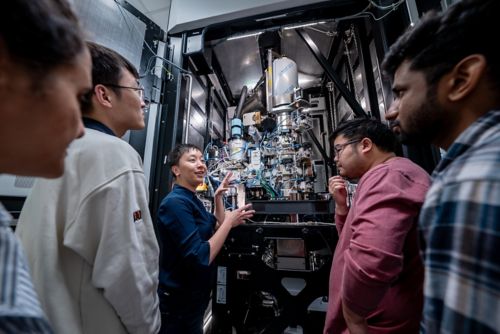St. Jude Family of Websites
Explore our cutting edge research, world-class patient care, career opportunities and more.
St. Jude Children's Research Hospital Home

- Fundraising
St. Jude Family of Websites
Explore our cutting edge research, world-class patient care, career opportunities and more.
St. Jude Children's Research Hospital Home

- Fundraising
Shared Resources help Elizabeth Kellogg, PhD, take fundamental research to the next level
When Elizabeth Kellogg, PhD, Department of Structural Biology, came to Memphis in 2023, she was driven by one thing: possibility.
To Kellogg, a 2021 Pew Biomedical Scholar and 2023 Margaret Oakley Dayhoff Award winner, St. Jude offered an unparalleled level of support for her research through shared resources and core facilities, a collection of state-of-the-art technologies staffed by experts who partner with faculty members like Kellogg to advance their scientific endeavors.
“I knew of the faculty that were here but didn’t fully appreciate the scope of St. Jude research,” explained Kellogg. “I came to know more through a symposium and saw how different it was, how things that wouldn’t be possible otherwise would be possible here.”
Kellogg’s research into bacterial RNA–guided clustered regularly interspaced short palindromic repeats (CRISPR) transposons (i.e., DNA that can move locations within a genome) carries enormous potential for gene editing research. The combination of CRISPR–Cas genome-editing, transposons, and correctly designed guide RNAs enables genome modification with incredible accuracy and efficiency.
This work requires a tightly coordinated multidisciplinary effort. “There are projects we wanted to pursue, but we were limited by access to what we needed,” Kellogg said. “That made the decision to come to St. Jude easy.”
Cryogenic electron microscopy (Cryo-EM) is a cornerstone technique in Kellogg’s lab, as it enables her team to gain mechanistic insights into CRISPR transposons in subcellular detail. Work published by Kellogg and colleagues in Nature in 2022 showed how they harnessed the technique to present the first full views of CRISPR-guided gene insertion, which was a landmark achievement. Her team built on this work and published in Molecular Cell in 2023, bringing to light fine details about the protein TniQ, which facilitates the transposition process. The shared resources at St. Jude are well positioned to enable Kellogg to expand upon her protein engineering background and take her insights to the cellular level.

Elizabeth Kellogg, PhD, aims to combine her cryo-electron microscopy expertise with the abundant shared resources at her disposal to accelerate discovery at St. Jude.
“We are using many shared resources — the Cryo-EM Center, but also the Cell and Tissue Imaging Center. We’re pursuing a correlated light electron microscopy project, which was exceedingly difficult before we came to St. Jude because we had to learn how to do much of it ourselves,” Kellogg explains. “The data we’re now getting back is beautiful because the experts are the ones doing it.”
The Single Molecule Imaging Center, the Hartwell Center for Biotechnology, the Protein Technologies Center, and the Center for Advanced Genome Editing will also help advance Kellogg’s research. She highlights the unique ability to collaborate and learn from the experts who operate these facilities as an added value.
“The setup of these resources means we can participate in the whole process. The experts are there to guide us in designing the experiments, to shepherd us through the whole process, and to help analyze the data. But we are ultimately the ones responsible for driving the project,” said Kellogg.
At St. Jude, Kellogg firmly believes she can receive the support she needs to pursue groundbreaking research; possibilities are now becoming realities. “We’ve been doing things that we’ve only ever dreamed of, and now that we’re here, we’ve been able to accomplish more in less time; it’s a dream come true.”